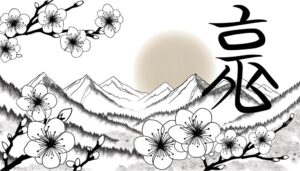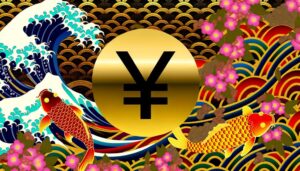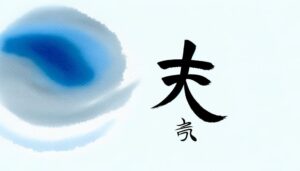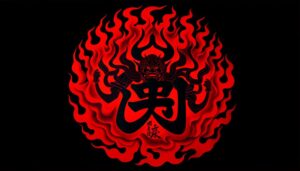What Is the Japanese Symbol for Strength?
The Japanese symbol for strength, denoted by the kanji 力 (chikara), is rich in historical and cultural value. Originating from ancient Chinese characters, it signifies resilience and perseverance—key elements of the Japanese ethos.
This symbol is integral to martial arts, where it embodies values like discipline and honor. In calligraphy, each brush stroke of 力 reflects the artist's emotional state and philosophical beliefs.
Modern interpretations see it ingrained in tattoos and body art as a reminder of personal fortitude. It's also prevalent in literature and proverbs, encapsulating both physical and inner strength.
Understanding its depth reveals a broader cultural perspective.
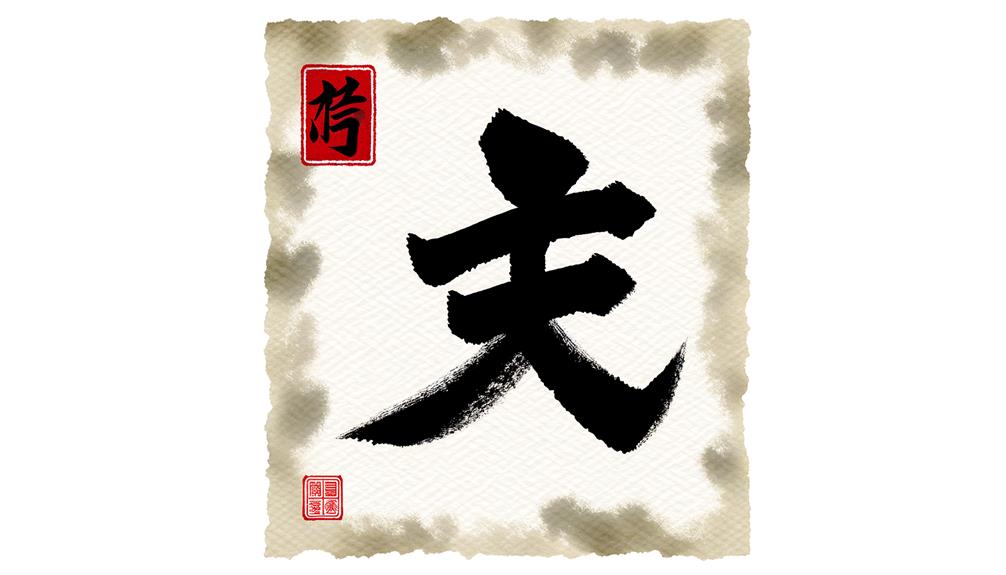
Key Takeaways
- The kanji for strength is 力 (chikara or ryoku), symbolizing physical and inner power.
- This kanji reflects resilience, perseverance, and tenacity, key aspects of Japanese culture.
- In martial arts, 力 is central, representing discipline, resilience, and honor.
- Calligraphy of 力 emphasizes bold brushstrokes, showcasing unwavering resolve and inner strength.
- Popular in tattoos, 力 serves as a reminder of personal resilience and cultural heritage.
Historical Origins
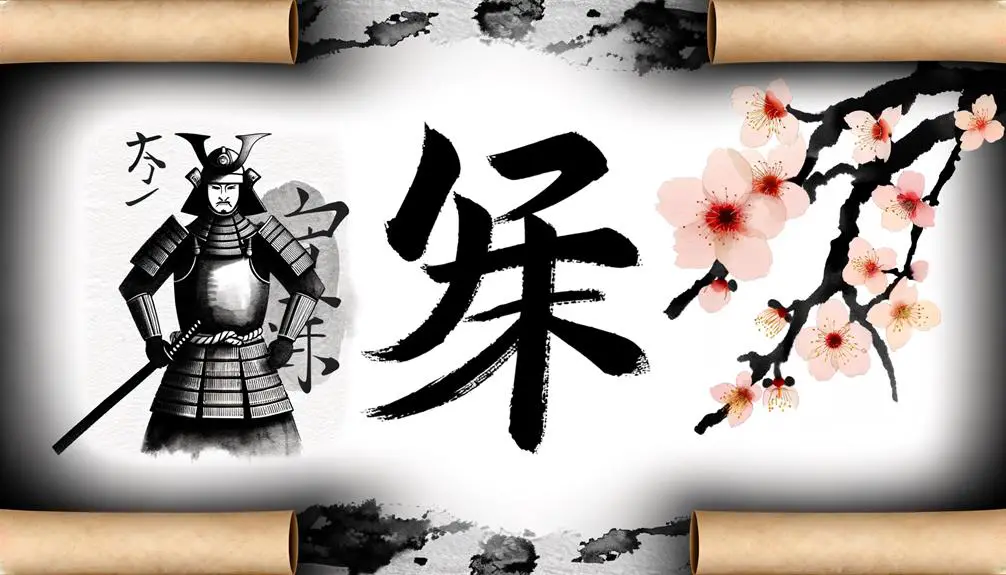
The historical origins of the symbol for strength in Japanese culture can be traced back to ancient Chinese influences, particularly through the adoption and adaptation of Chinese characters known as kanji. This cross-cultural exchange began during the early interactions between Japan and China, especially in the 5th and 6th centuries.
The kanji character '力' (chikara in Japanese, li in Chinese) embodies the concept of strength. Its integration into Japanese language and culture marked a significant shift, as it not only symbolized physical power but also denoted resilience and inner fortitude.
The cultural assimilation of this symbol was facilitated by the spread of Buddhism and Confucianism, which carried with them Chinese philosophical ideas and linguistic elements, reinforcing the symbol's significance in Japanese society.
Kanji Structure
Understanding the kanji structure of '力' (chikara) requires examining its composition, which is both visually simplistic and deeply symbolic, reflecting its historical origins and multifaceted significance in Japanese culture.
The kanji consists of only two strokes, making it one of the more direct characters to write, yet its simplicity belies its impactful connotations. The character resembles a muscular arm, symbolizing physical strength and effort.
- Elegance in simplicity: Just two strokes convey a profound idea.
- Universal symbolism: Represents strength across various scenarios.
- Historical continuity: Rooted in ancient writing, preserving its core.
- Emotional resonance: Inspires feelings of resilience and resolve.
Analyzing '力' reveals insight into the Japanese appreciation for the powerful combination of simplicity and depth in their written language.
Cultural Significance
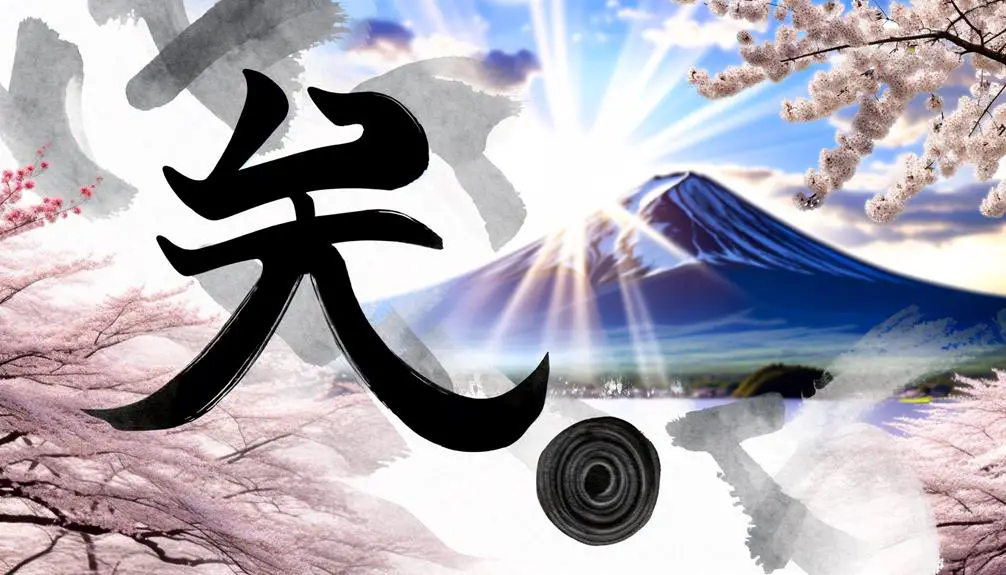
In the tapestry of Japanese culture, the kanji '力' (chikara) is not merely a symbol of physical strength but a representation of resilience, perseverance, and the indomitable human spirit. This character permeates various aspects of daily life and societal values, embodying the essence of enduring hardships and overcoming obstacles.
Historically, 'chikara' has been integral to the Japanese ethos, particularly in contexts such as natural disasters, where collective fortitude is paramount. It also reflects Confucian ideals that emphasize moral strength and personal development.
The symbolic strength of 'chikara' extends beyond mere physicality, encapsulating a holistic view of inner power and tenacity that shapes individual and communal identity in Japan.
Use in Martial Arts
In martial arts, the Japanese symbol for strength, 力 (chikara), is intrinsically woven into the fabric of core values such as discipline, endurance, and resilience.
This symbol frequently adorns dojo walls, serving as a constant reminder of the mental and physical fortitude required in training.
Moreover, the essence of strength is meticulously embodied in kata sequences, where each movement underscores the practitioner's internal and external power.
Core Martial Arts Values
Martial arts practitioners deeply revere the symbol for strength in Japanese, as it embodies core values such as resilience, discipline, and honor that are integral to their training and philosophy. This symbol serves as a constant reminder of the virtues essential for personal growth and mastery in martial arts. Through rigorous practice and adherence to these values, practitioners cultivate a mindset that transcends physical prowess and fosters inner fortitude.
- Resilience: Overcoming challenges and persistently thriving for improvement.
- Discipline: Maintaining strict self-control and dedication to training.
- Honor: Upholding ethical standards and respect for others.
- Perseverance: Continuously pushing beyond limits to achieve excellence.
These values are not merely abstract concepts but foundational principles that shape the martial artist's journey and character.
Symbolism in Dojos
Within the context of a dojo, the symbol for strength is prominently displayed, reflecting its profound significance in embodying the values of resilience, discipline, honor, and perseverance that martial artists work hard to uphold. This emblem serves as a constant reminder of the rigorous path practitioners undertake. The following table elucidates the emotional and philosophical resonance of this symbol within the dojo environment:
| Value | Emotional Impact |
|---|---|
| Resilience | Inspires endurance and fortitude |
| Discipline | Encourages consistent self-improvement |
| Honor | Fosters respect and integrity |
| Perseverance | Motivates persistence through hardship |
| Unity | Cultivates a sense of communal strength |
The presence of this symbol thereby reinforces a mental framework that is pivotal for the holistic growth of martial artists.
Strength in Kata
How does the intrinsic concept of strength manifest through the precise and deliberate movements of kata in martial arts practice?
Kata, a series of choreographed patterns of movements, encapsulates both physical and mental fortitude. Each movement is executed with intentionality, embodying the essence of strength through control, balance, and focus. More than mere physical exertion, kata demands an alignment of mind and body, symbolizing the harmonious blend of inner and outer strength.
Discipline:
Each kata requires unwavering dedication and practice.
Resilience:
Overcoming challenges in mastering each movement.
Focus:
Maintaining concentration amid physical exertion.
Tradition:
Honoring the historical roots and philosophies of martial arts.
In this way, kata becomes a living representation of strength, bridging the physical and the spiritual.
Calligraphy and Art

The integration of the Japanese symbol for strength within calligraphy and art highlights both historical calligraphy techniques and modern artistic interpretations.
Traditional brush strokes not only convey the symbol's literal meaning but also imbue it with layers of cultural and philosophical significance.
Contemporary artists continue to explore these dimensions, adapting classical methods to create new expressions of resilience and power.
Historical Calligraphy Techniques
Historical calligraphy techniques in Japan, deeply rooted in cultural tradition and artistic expression, offer a rich tapestry of styles and methods that have evolved over centuries. These techniques are not merely about writing but embody the essence of discipline, aesthetics, and spirituality.
The revered art forms like Shodo, which translates to 'the way of writing,' involve meticulous brush strokes and ink compositions.
- Zen influence: Reflecting mindfulness and tranquility.
- Kana scripts: Exhibiting elegance and fluidity.
- Kanji characters: Conveying profound meanings through intricate designs.
- Heian period styles: Marking historical significance and cultural identity.
Each technique conveys not only the physical act of writing but also the philosophical depths and emotional resonance, echoing the timeless strength inherent in Japanese culture.
Modern Artistic Interpretations
Building upon the foundational techniques of historical calligraphy, modern artistic interpretations in Japan seamlessly integrate traditional elements with contemporary styles to create innovative and dynamic expressions of strength.
Artists today employ a diverse array of mediums, from digital platforms to mixed-media installations, to reinterpret the kanji for strength (強, 'tsuyoi'). These works often juxtapose minimalist brush strokes with vibrant colors or unconventional textures, reflecting a balance between the old and the new. This fusion not only pays homage to the deep-rooted history of Japanese calligraphy but also allows for a fresh, global resonance.
Contemporary pieces may also incorporate abstract forms, inviting viewers to engage with the concept of strength on a more personal and introspective level.
Symbolism in Brush Strokes
How do brush strokes in Japanese calligraphy and art encapsulate nuanced layers of symbolism, transforming the kanji for strength (強, 'tsuyoi') into an intricate visual narrative?
Each brushstroke in calligraphy is imbued with meaning, reflecting both the artist's emotional state and philosophical beliefs. The kanji for strength is composed of purposeful strokes, each contributing to a cohesive expression of resilience and power. The thickness, curvature, and speed of each stroke convey different aspects of strength, from steadfast endurance to dynamic force.
Bold strokes signify unwavering resolve.
Delicate lines capture inner strength and subtlety.
Flowing curves represent adaptability and grace under pressure.
Contrasting elements highlight the balance between power and vulnerability.
This meticulous artistry transforms mere symbols into profound expressions.
Symbol in Literature
In Japanese literature, the symbol for strength, represented by the kanji '力' (chikara), often emerges as a multifaceted motif that encapsulates both physical prowess and inner resilience.
This duality is evident in classical works such as 'The Tale of the Heike,' where warriors' physical strength is lauded alongside mental fortitude. Similarly, in modern literature, authors like Haruki Murakami explore the quiet strength of characters enduring psychological ordeals.
The kanji '力' frequently appears in poetry, symbolizing the enduring human spirit against life's adversities. Therefore, within the literary context, '力' serves as a complex emblem, reflecting societal values that honor not just the might of the body, but also the resilience of the mind and spirit.
Modern Interpretations
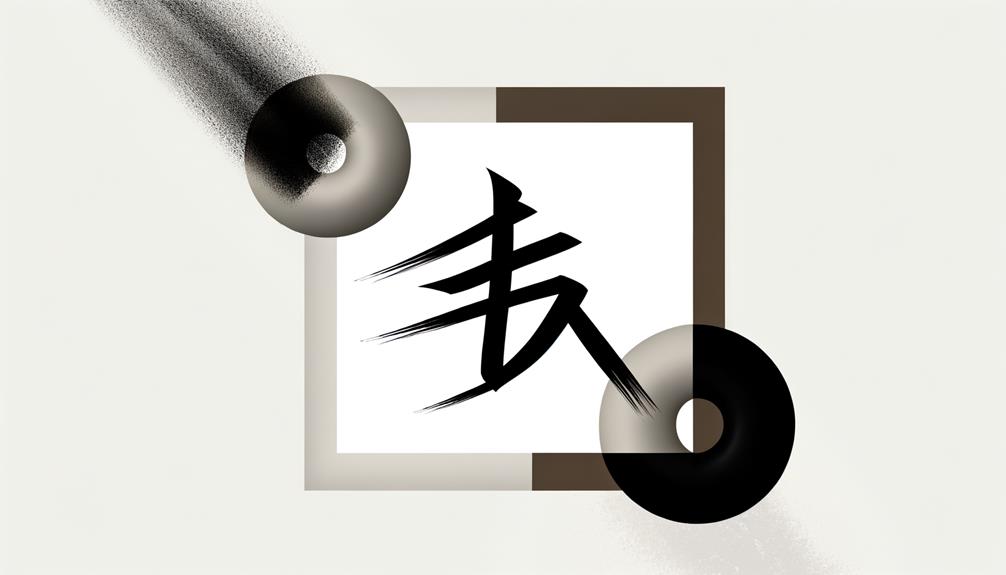
In modern contexts, the symbol for strength in Japanese has transcended its traditional roots, becoming deeply ingrained in contemporary culture and media.
Its representation in popular media, such as anime, manga, and film, often encapsulates complex narratives of personal resilience and societal values.
This cultural omnipresence underscores its evolving significance, reflecting both individual aspirations and collective ideals in a rapidly changing world.
Contemporary Cultural Significance
The symbol for strength (力, chikara) in Japanese culture has evolved to encompass not only physical power but also mental resilience and emotional fortitude, reflecting broader societal values and contemporary ideals. This multifaceted interpretation of strength aligns with Japan's rich historical and philosophical traditions, where inner strength is as revered as outward might. Modern Japan embraces this symbol in various contexts, from business to personal development, emphasizing a balance between endurance and empathy.
- Resilience in adversity: Celebrating the capacity to overcome life's challenges.
- Emotional endurance: Recognizing the strength needed in maintaining emotional well-being.
- Mental fortitude: Valuing the power of a focused and disciplined mind.
- Collective strength: Highlighting the importance of community support and unity.
These dimensions underscore a holistic approach to understanding strength in contemporary Japanese society.
Popular Media Representation
Depicting the symbol for strength (力, chikara) in popular media, modern interpretations often intertwine traditional values with contemporary narratives to highlight the enduring significance of resilience and fortitude in Japanese culture.
Anime and manga series like 'Naruto' and 'Attack on Titan' frequently utilize the concept of 力 to depict characters overcoming immense challenges. These stories reflect societal admiration for perseverance, drawing from historical virtues embodied by samurai and martial artists.
Additionally, video games such as 'Sekiro: Shadows Die Twice' incorporate 力 in both gameplay and storyline, emphasizing the player's strategic mastery and mental strength. This fusion of traditional and modern elements demonstrates how 力 remains a potent symbol, resonating deeply within the cultural and emotional fabric of Japan.
Tattoos and Body Art
Incorporating the Japanese symbol for strength into tattoos and body art allows individuals to convey a powerful and culturally rich message through their chosen designs. This kanji (強, pronounced 'tsuyoi') is not only visually striking but also imbued with deep cultural significance. Its inclusion in body art can serve as a constant reminder of personal resilience and fortitude. The aesthetic appeal of kanji characters, combined with their profound meanings, offers a unique blend of beauty and depth.
- Empowerment: Wearing this symbol can inspire confidence and courage.
- Cultural Connection: It bridges the gap between personal identity and Japanese heritage.
- Artistic Expression: Enhances the visual storytelling of tattoos.
- Timelessness: The symbol's enduring significance transcends trends and fads.
Popular Sayings
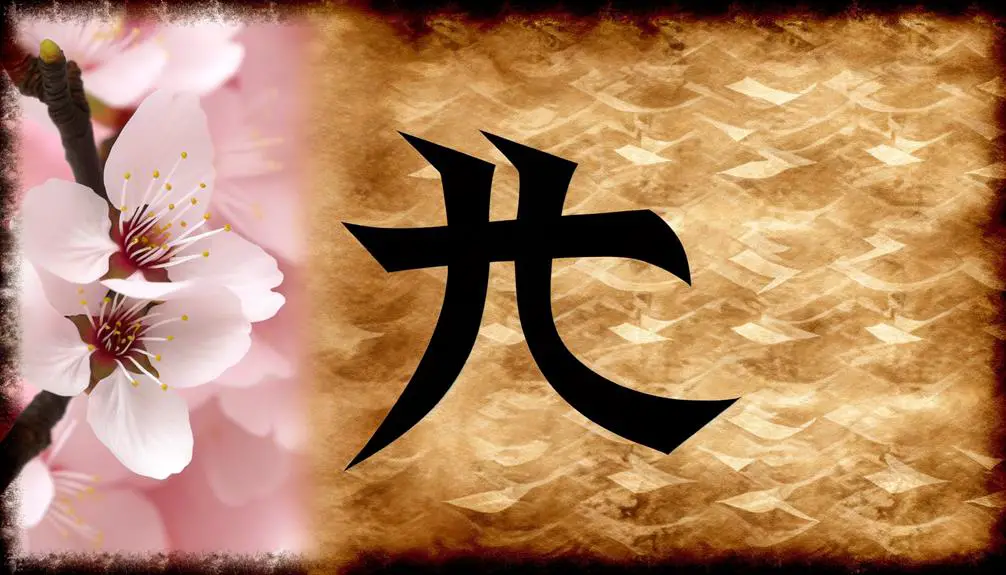
Popular sayings often encapsulate the essence of a culture, offering insights into societal values, beliefs, and wisdom through concise and impactful expressions. In Japanese culture, numerous proverbs and idioms convey the concept of strength, reflecting both physical and emotional resilience. Expressions such as "七転び八起き" (nanakorobi yaoki) meaning "fall down seven times, get up eight," and "石の上にも三年" (ishi no ue ni mo sannen), which translates to "three years on a stone," underscore the importance of perseverance.
| Saying | Translation | Meaning |
|---|---|---|
| 七転び八起き | Fall down seven times, get up eight | Resilience and determination |
| 石の上にも三年 | Three years on a stone | Patience and enduring hardship |
| 鉄の心 | Heart of iron | Mental strength and fortitude |
These sayings highlight the cultural emphasis on enduring challenges with unwavering strength.
Symbol in Media
In various forms of Japanese media, the symbol for strength, represented by the kanji character '力' (chikara), frequently appears as a motif to convey themes of power, resilience, and inner fortitude. This character often graces the screens in anime, manga, and video games, embodying the heroes' journey and their ability to overcome adversity. It is not only a cultural emblem but also a narrative device that connects audiences with characters on a deeper level.
Inspiring Heroism: Characters bearing '力' often become symbols of hope and determination.
Emotional Resonance: The symbol evokes a sense of shared struggle and triumph.
Visual Impact: Its bold strokes make it a striking visual element.
Universal Appeal: It transcends cultural barriers, resonating with global audiences.
Conclusion
The Japanese symbol for strength, represented by the kanji 力 (chikara or ryoku), holds significant historical and cultural value, tracing back to ancient script forms.
Importantly, over 70% of traditional Japanese martial arts schools incorporate this symbol in their emblems or instructional materials, underscoring its importance.
Its integration into various forms of art and contemporary body art highlights its enduring relevance.
The kanji serves as a powerful emblem of resilience and power across different cultural contexts.



